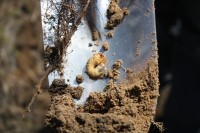Jack pine (Pinus banksiana) is an important tree species to Saskatchewan. Of Saskatchewan’s commercial tree species, jack pine makes up approximately 17 per cent of the provincial forest types (PFT) in the commercial forest and over 38 per cent of the PFTs in an area called the Island Forests. The Island Forests in Saskatchewan are located within a transition area between boreal forest to the north and grasslands to the south (the Boreal Plains ecozone). This region marks both the southern advance of the boreal forest and the northern limit of arable agriculture (Acton, Padbury and Stushoff 1998). The area of interest is described as a sandy loam site that is prone to drought and was heavily infected with Lodgepole pine dwarf mistletoe (Arceuthobuium americanium) and was also disturbed by wildfire in 1995. The Lodgepole pine dwarf mistletoe has the most significant impact on the Island Forests with more than 13 per cent (26,453 ha) of jack pine infected with this parasite.
However, another pest of interest to the Island Forests was discovered in the fall of 2011: the June bug! Appropriately, this story of jack pine and June bugs begins in June of 2011. An area of land that was not sufficiently restocked (NSR) in the Island Forests was fill-planted using jack pine 412 (1+0) container stock planted at 2 m spacing. By the fall of 2011, dead seedlings had been discovered in this plantation during a routine walk through. When the seedlings were dug up to determine cause of death, it was very strange to see that the entire plug (4 cm across and 12 cm long), the radicle and all lateral roots were stripped from the seedlings (see Figure 1). As we do with all things related to dead and dying trees here in Saskatchewan, the dead seedlings were brought to our provincial forest entomologist and pathologist, Dr. Rory McIntosh. He diagnosed the damage to be consistent with the work of June beetles: the pesky Phyllophaga spp. (Figure 2)! Dr. McIntosh provided the following life cycle description.


L-R: June Bug (Photo credit Christine Simpson, MOE); dead jack pine with damaged radicle (Photo credit Rory McIntosh, MOE); dead jack pine with june bug (Photo credit Christine Simpson, MOE).
The common life cycle of the destructive and abundant Phyllophaga spp. extends over three years. While these white grubs normally feed on grass roots, they will eat the roots of tree seedlings, especially when grass roots are scarce, as was the case in the Island Forests. In May or June the adult beetles will emerge from the soil and feed on broad-leaved hardwoods. The adults mate in the evening (how romantic) and at dawn the females return to the ground to deposit 15 to 20 eggs, one to eight inches deep in the soil. Eggs hatch about three weeks later into the young larvae that feed upon the roots and decaying vegetation throughout the summer. In the fall, they migrate downward in the soil, to a depth of up to one and a half metres, and remain inactive until the following spring. The spring can see the most damage as the larvae return near the soil surface to feed on plant roots. Seedling plugs that are J-rooted because of careless planting are often killed first. In the autumn, the larvae again migrate deep into the soil to overwinter, returning to just below the soil surface for the third spring to feed on plant roots until they are fully grown by late spring. The grubs then form oval earthen cells and pupation begins! The adult emerges from the earthen cell a few weeks later, but doesn’t leave the ground just yet. The beetles overwinter and emerge the following year in May or June, when the next round of feeding, mating and egg-laying takes place.
You can see how by the fall of 2011 the larvae had already eaten the roots from the jack pine plugs in the Island Forests and left evidence in the red, dead seedlings. It is estimated that up to 250 hectares of plantation have been damaged, or approximately 270,000 seedlings. The cost of re-treating these sites could be as much as $300,000. The June bug is native to Saskatchewan and generally has a three-year cycle. We estimate that 2011 was year two of the cycle. The grubs we found this past spring indicate that 2012 is year three and, hopefully, the end of the cycle. We’ve got our fingers crossed that replanting these sites in the spring of 2013 will avoid major root damage and allow the seedlings to get bigger and be better able to withstand any further June beetle attack.
Acton, D.F., G.A. Padbury, C.T. Stushoff. March, 1998. The Ecoregions of Saskatchewan. Prepared and edited by Saskatchewan Environment and Resource Management. Canadian Plains Research Centre/Saskatchewan Environment and Resource Management. University of Regina. 205 pgs.
Vicki Gauthier is a professional forester with the Saskatchewan Ministry of Environment.
- Log in to post comments
